Physical Address
304 North Cardinal St.
Dorchester Center, MA 02124
![]() Access video lecture content for this chapter online at Elsevier eBooks+
Access video lecture content for this chapter online at Elsevier eBooks+
Despite the cardinal role played by perioral aesthetics in facial pulchritude or youthful appearance, minimal attention has been paid in the literature to correcting dysmorphologies of this region. There are two categories of patients who seek aesthetic improvement in the perioral area. In the younger patient, lip augmentation, lip shortening, or lip elongation can be applied singularly to enhance and harmonize the appearance of this area. In the older patient, skin changes (including dynamic and static lines), the tilt of the oral commissures, and lip ptosis all play a major role. Aging also may result in dyschromias. Volume loss and gravity can lead to an exaggerated depth of the nasolabial creases or marionette lines. The lips become thin, losing “crispness” in their white roll and philtral columns, and the surrounding skin loses its subcutaneous fat, allowing accentuation of the fine wrinkles resulting from repetitive orbicularis oris action. Ptosis of the malar fat pads lateral to the nasolabial creases combined with thinning of the skin over the creases draws attention to the aging perioral area, making depth over the nasolabial crease an issue to contend with during treatment.
Because traditional rhytidectomy techniques often do not sufficiently address the perioral area, patients may be disappointed postoperatively about an imbalance of the face or insufficient improvement. Recognizing the changes that occur with aging in the perioral area and subsequently exercising the options available to rejuvenate the lower face are necessary to providing optimal facial harmony. Here we discuss the patient evaluation process and describe various techniques for aesthetic enhancement of the perioral region for patients of all ages.
Chin projection and shape is closely related with face aesthetics in general and particularly with perioral aesthetics. In this chapter we therefore discuss perioral aesthetics along with chin and genioplasty.
An understanding of the perioral region’s structural anatomy allows the surgeon to choose the most appropriate and long-lasting treatment, whether that is surgery, soft-tissue fillers, fat grafting, skin resurfacing, or some combination of these techniques. The perioral region is bounded by the nasolabial creases superolaterally, the labiomental crease caudally, and the nasal base cephalically. Anatomical landmarks of this region include the philtrum, philtral columns, philtral dimple, Cupid’s bow, vermilion border, nasolabial crease, and labiomental crease ( Fig. 9.13.1 ). The lower third of the face is divided again into thirds, with the upper one-third extending from the subnasale to the stomion and the lower two-thirds extending from the stomion to the menton. The oral commissure lies within a vertical plane drawn from the medial limbus of the iris. The lips should meet on repose. A key anatomic feature of the upper lips is the Cupid’s bow complex, formed by two high points of the vermilion joined by a V-shaped depression centrally. The upper lip usually has 75%–80% of the lower lip volume with raised philtral ridges. Ideally, in the youthful face, the upper lip projects minimally more anteriorly than the lower lip. The lower lip shows fullness in the central portion. The white roll refers to the raised line of skin that separates the cutaneous and red lip; it is prominent in youth. Aesthetically, 2–3 mm of the upper incisors may show in repose, but the full length of the incisors should show while smiling.
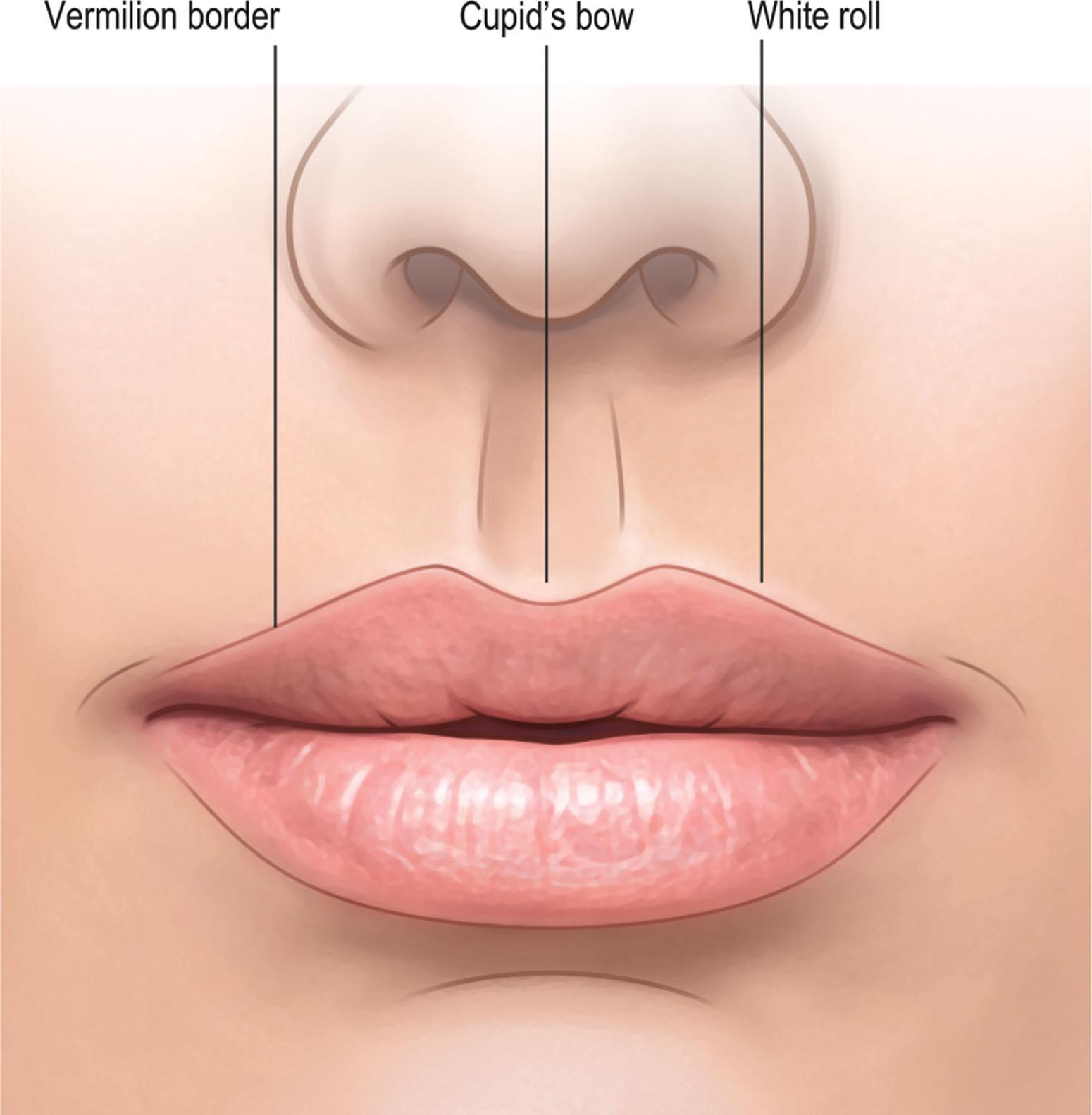
The muscles of the perioral region are arranged in distinct patterns, and there are various classification systems. Nairn’s classification divides them into three groups based on attachments to the lip. Group I muscles enter the modiolus, which is the area of convergence for the tendinous fibers of muscles entering the lip. Group II muscles enter the upper lip, and Group III muscles enter the lower lip. The orbicularis oris, levator anguli oris, depressor anguli oris, risorius, zygomaticus major, incisivus superioris, incisivus inferioris, and buccinator muscles comprise the Group I muscles. Group II muscles enter the upper lip as a flat sheet, and their fibers run at right-angles to the fibers of the orbicularis oris. These muscles include the levator labii superioris, levator labii superioris alaeque nasi, and zygomaticus minor. Group III muscles include the depressor labii inferioris, mentalis, and platysma muscles. As a group, these function opposite to the way the Group II muscles work for the upper lip.
Sensory innervation of the upper lip comes from the superior labial and superior alveolar nerves, which are divisions of the infraorbital branches of the maxillary (V 2 ) nerve. The mandibular (V 3 ) divisions of the trigeminal nerve give rise to the inferior alveolar nerve, of which the mental nerve is the branch supplying the lower lip and chin. Blood supply is derived from the inferior and superior labial branches of the facial artery. The angular artery (off the distal facial artery) extends along the pyriform aperture and gives off branches.
Although we are not going to discuss the facial analysis in detail within this chapter, the entire face needs to be analyzed before focusing on the chin. The chin is defined by a graceful transition of the mandibular angles toward the midline. It results in a double light reflection in males and single light reflection in females. Both the examination and photographic analysis are used to evaluate chin deformities. The patient’s entire face should be examined for any aesthetic imbalance. Either a simple chin asymmetry or the mandibular deformity can cause chin asymmetry. Upon examination of the lower face front view, the first part to note is the lips and commissural line-up. Except for facial paralysis, any distortion of commissural line usually indicates skeletal asymmetry. Therefore, genioplasty alone may not be an appropriate treatment. If the oral commissure is lined up horizontally and the occlusal plane is horizontal as well, but the chin is shifted, this asymmetry is considered an isolated chin deformity. However, a tilt on oral commissure or occlusal plane or if the midline of maxilla does not correspond to the midline of mandible, would indicate a mandibular shift or maxillary–mandibular rotation. Again, it is critical to emphasize that while the underlying foundation is positioned abnormally, any surgery that corrects only the asymmetry of the chin will not result in an ideal aesthetic outcome.
The life-size photographic facial analysis, coupled with clinical examination, can help to decide the number of millimeters advancement needed to achieve those aesthetic goals. Not only is hard-tissue analysis on cephalograms essential, but also soft-tissue analysis on life-size photographs assists in detailed planning and ensures increased predictability. Small fractions, such as 1.0–2.0 millimeters can make a significant difference in the harmony of the facial structures.
The chin projection should be viewed on the profile picture for assessment. The most prominent portion of chin is called the pogonion. In an ideal chin projection, a line connecting the upper and lower lip will touch the pogonion, which is called Riedel’s line.
An imaginary vertical line connecting the mid-glabella to the midline of the chin is the midline of the face, which divides the chin into two equal parts. To determine any chin deformities, one needs to assess the vertical and horizontal dimensions. The cardinal determinants of chin harmony are its projection symmetry and vertical length. The first step in full-face evaluation is to divide the face into three equal portions, with four horizontal lines on the life-size photograph in frontal view: one passing through the hairline, another passing through lower glabella, the next passing through the subnasale, and the last one passing through the most caudal portion of the chin, which is called the menton. To assess the vertical dimension, the lower third is subdivided using a line passing through the stomion ( Fig. 9.13.2 ) The length between the menton and the stomion should be twice the distance from the stomion to the subnasale. A vertical line passing through the mid-glabella and the tip of a straight nose determines any chin asymmetry. Projection of the chin is assessed on the profile view. There are several methods to evaluate the chin projection. The most practical one is Riedel’s plane. This line connects the most prominent portion of the upper lip to the most prominent portion of the lower lip and continues caudally. The pogonion touches this line in an ideally balanced chin-to-lip relationship ( Fig. 9.13.3 ). The labiomental groove is probably one of the most underrated features of the lower face. Generally, it is about 4 mm deep in a female and 6 mm deep in a male profile.
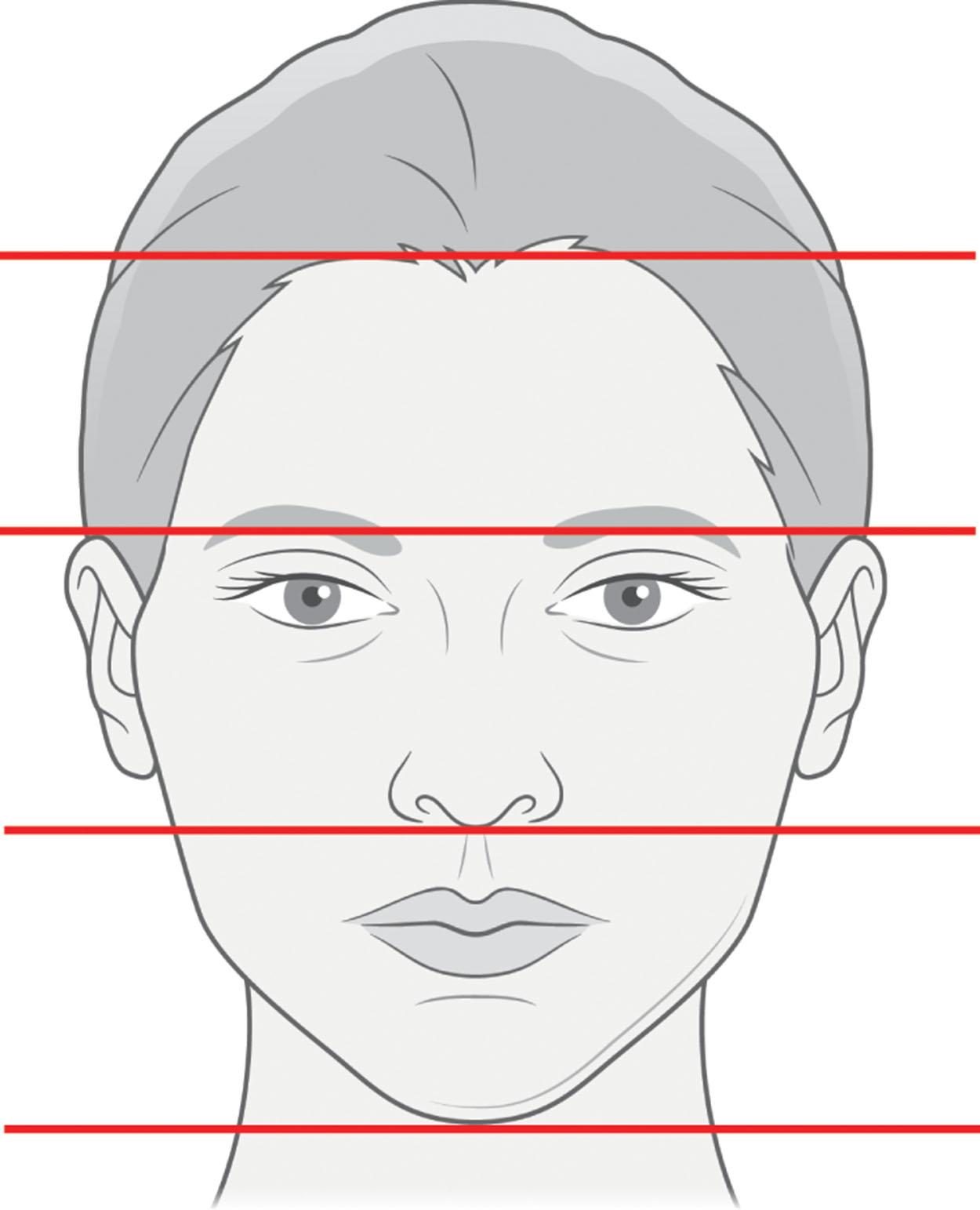
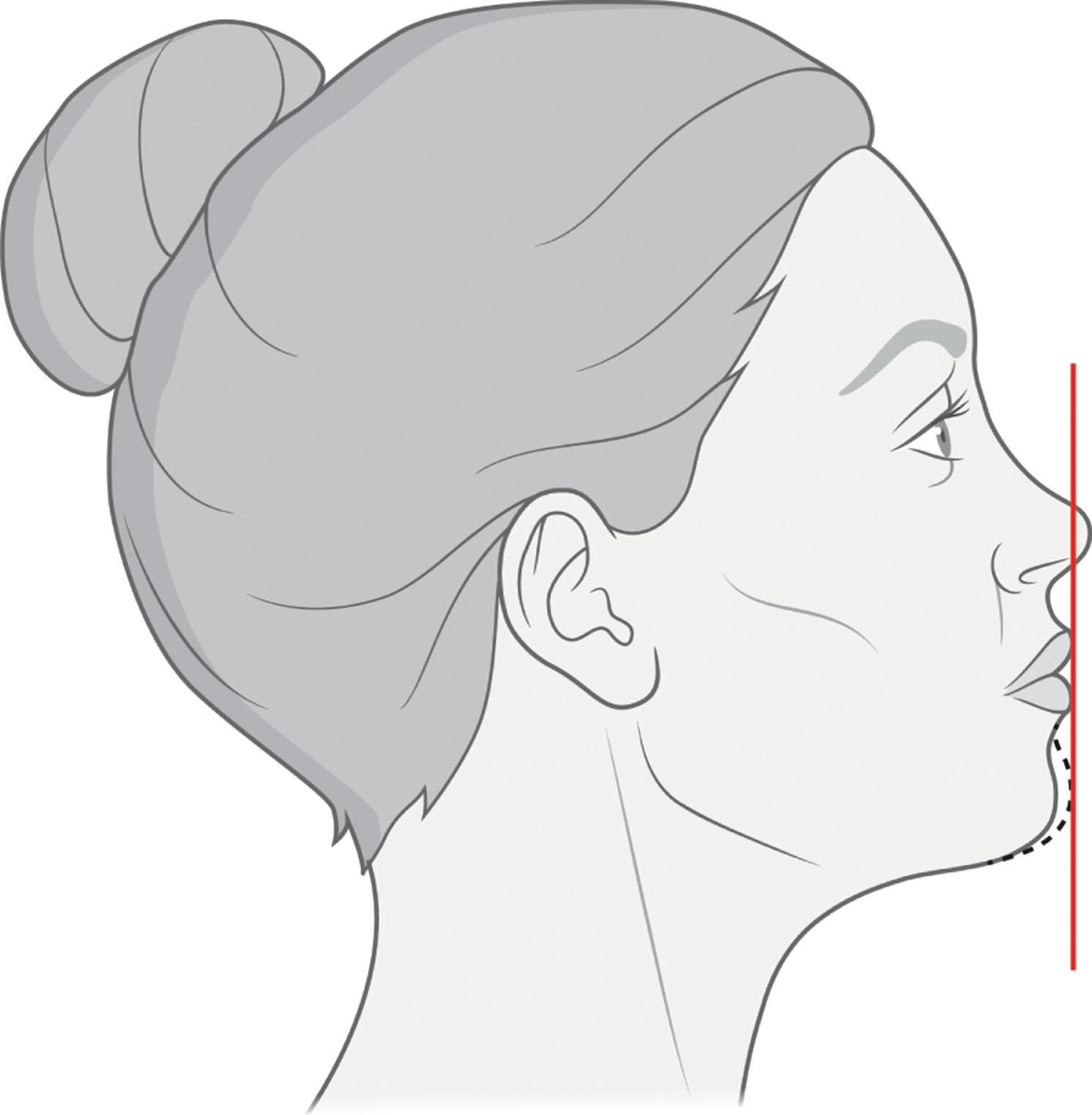
The shape of the maxillary–mandibular arch is also important. A very wide mandibular arch is the result of a wide mandibular body and would thus necessitate adjustment in chin osteotomy. An overhead view and basilar view help evaluate the nasal and chin line-up and malar projection, especially in patients with minimal asymmetry.
No patient should undergo a genioplasty without an intraoral examination. Any disharmony between the upper incisors and the lip indicates an underlying skeleton abnormality. In a relaxed position, 2.0 mm of upper incisor should be visible between the lips. This exposure reaches to the full length of the upper teeth on a full smile. Any excess visible gum above the crowns or inadequate tooth showing indicates abnormality of the underling maxilla or upper lip deficiency, and should be noticed. One of the most important parts of intraoral examination is dental occlusion, which has a role in the surgical planning. Any significant periodental disease should be eradicated completely in the patient undergoing genioplasty. Both the clinical examination and this type of chin analysis make the surgery plan more precise, which results in optimal outcome.
A careful examination of the perioral region may disclose one or several flaws. The area should be examined thoroughly to document these deformities. First, although most of the lip atrophy occurs with aging, hypoplastic lips can also be present in young patients. For these patients, the goal is to augment or increase volume. Second, patients could present with a descended stomion or elongated upper lip. Assessment of facial proportions is critical to identifying this imperfection. Third, it is important to make note of prominent radial wrinkling of both lips, which can be particularly noticeable on the upper lip. The physician should differentiate between dynamic lines (which appear only or mostly on animation) and static lines (which are present constantly). Fourth, patients may have a “downturned” or sad appearance to the creases and folds in the oral commissure area. Fifth, the depth of the nasolabial crease is important, and any asymmetry should be noted.
With the patient smiling, the amount of maxillary incisor show should also be checked. Again, an optimal amount of incisor show is 2–3 mm. Less tooth show is suboptimal, and more than 3 mm of gingival show can be displeasing. The amount of tooth show changes with age, and an inadequate tooth show should be corrected to rejuvenate the face. Patients with excessive incisor show can be referred to as having a “gummy smile”. These patients expose a broad strip of maxillary gingiva above the teeth when smiling. This exposure could be due to excess maxillary length or may be the result of a short or hypoplastic upper lip. Correction of this exposure involves lip augmentation, maxillary osteotomy with height reduction, or lip lengthening with or without augmentation, depending on the dysmorphology. Another cause of a gummy smile is hyperfunction of the lip elevators, which can be surgically corrected through lip elongation with or without rhinoplasty to correct the anterior nasal spine and depressor septi nasi muscles. Also, delayed passive eruption is a developmental problem of the teeth, which can result in an excess amount of gum covering the dental crown. This is particularly evident in dynamic motion. Gingivectomy and vestibuloplasty can correct this, and these are usually performed by a cosmetic dentist or oral maxillofacial surgeon.
Chin deformities can be classified to seven main categories ( Table 9.13.1 ): (I) macrogenia, which can be horizontal, vertical, or a combination of the two ( Figs. 9.13.4–9.13.6 ); (II) microgenia, which can be horizontal, vertical, or a combination of the two ( Figs. 9.13.7–9.13.9 ); (III) a combination of macrogenia and microgenia in different directions ( Figs. 9.13.10 & 9.13.11 ); (IV) asymmetric chin ( Figs. 9.13.12–9.13.14 ); (V) pseudomacrogenia; (VI) pseudomicrogenia; (VII) witch's chin deformity
| I |
|
| II |
|
| III |
|
| IV |
|
| V | Pseudomacrogenia |
| VI | Pseudomicrogenia |
| VII | Witch's chin deformity |
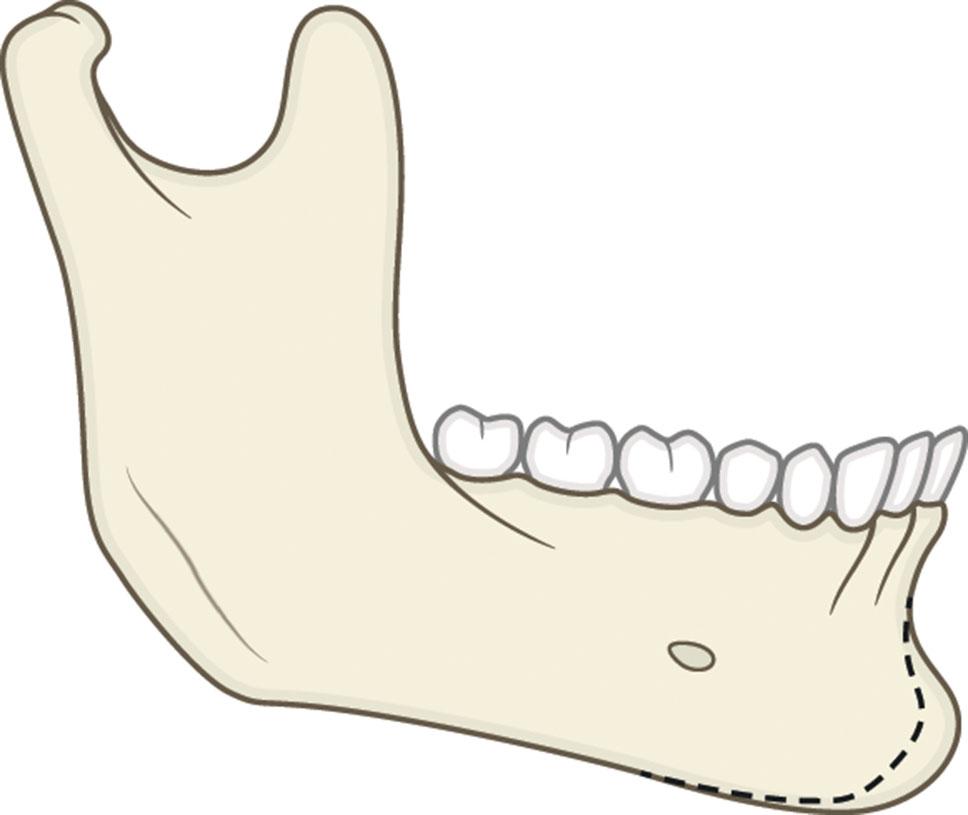
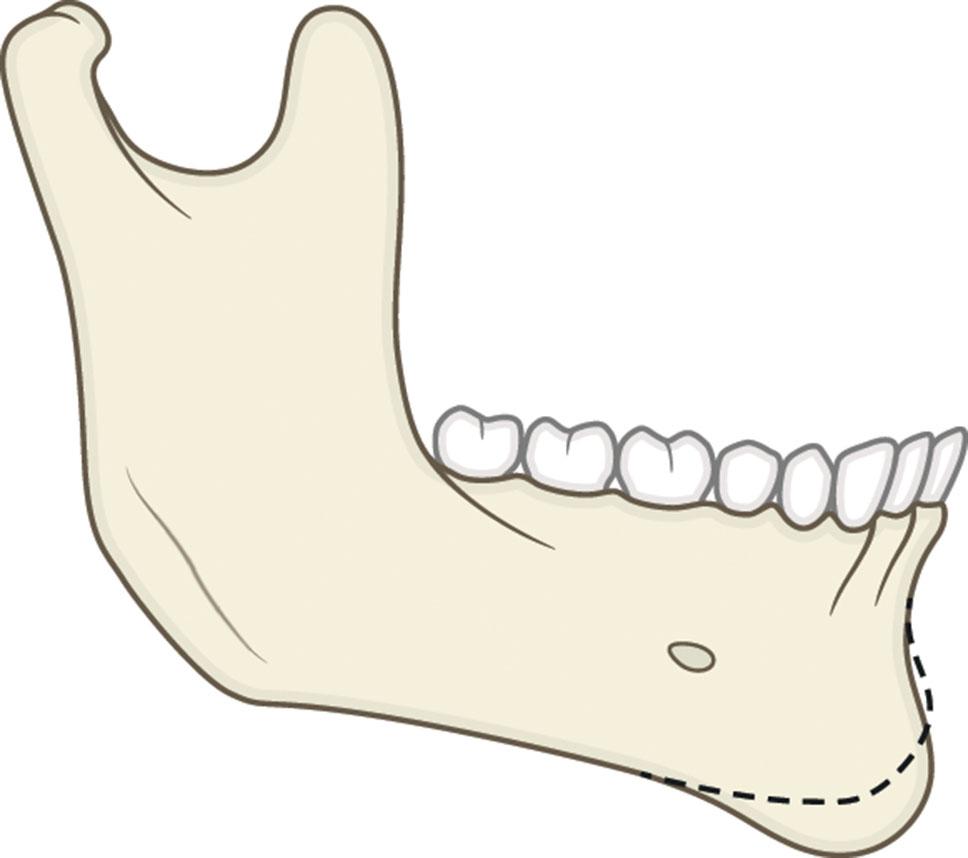
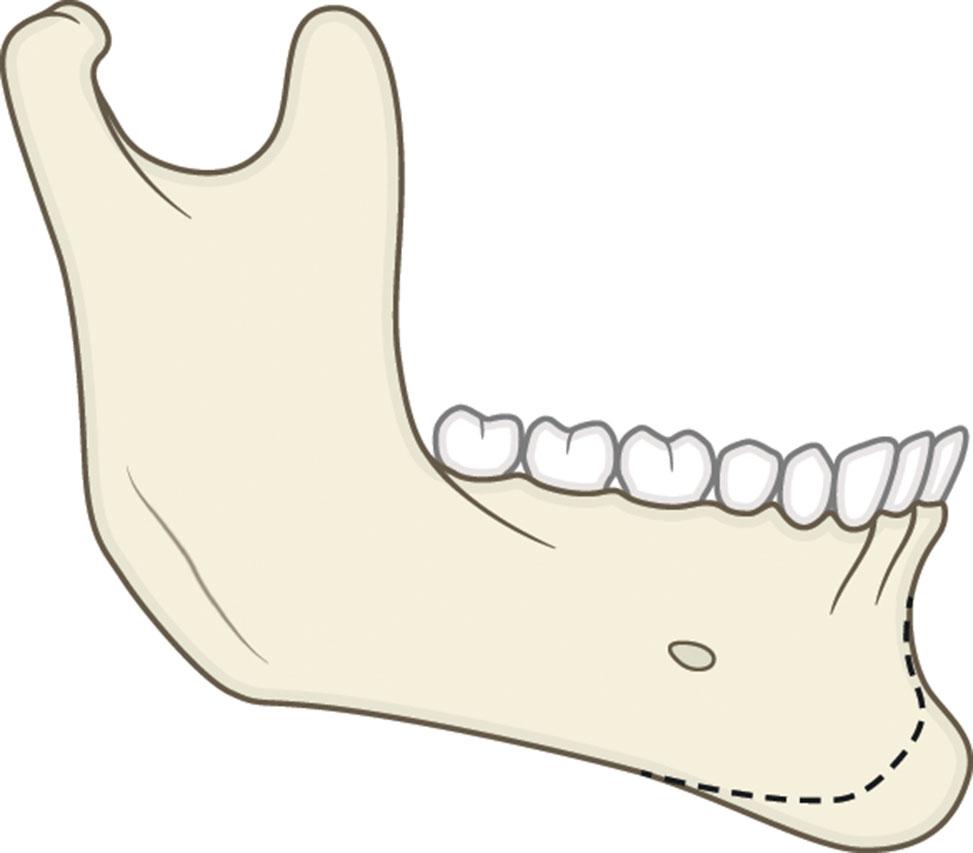
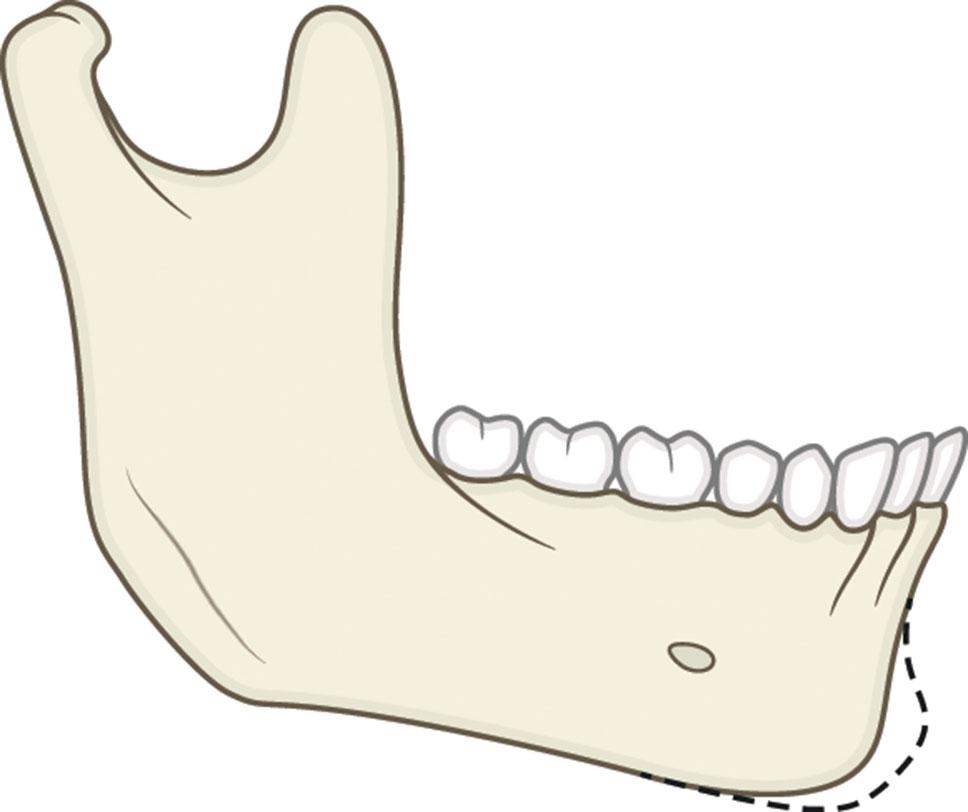
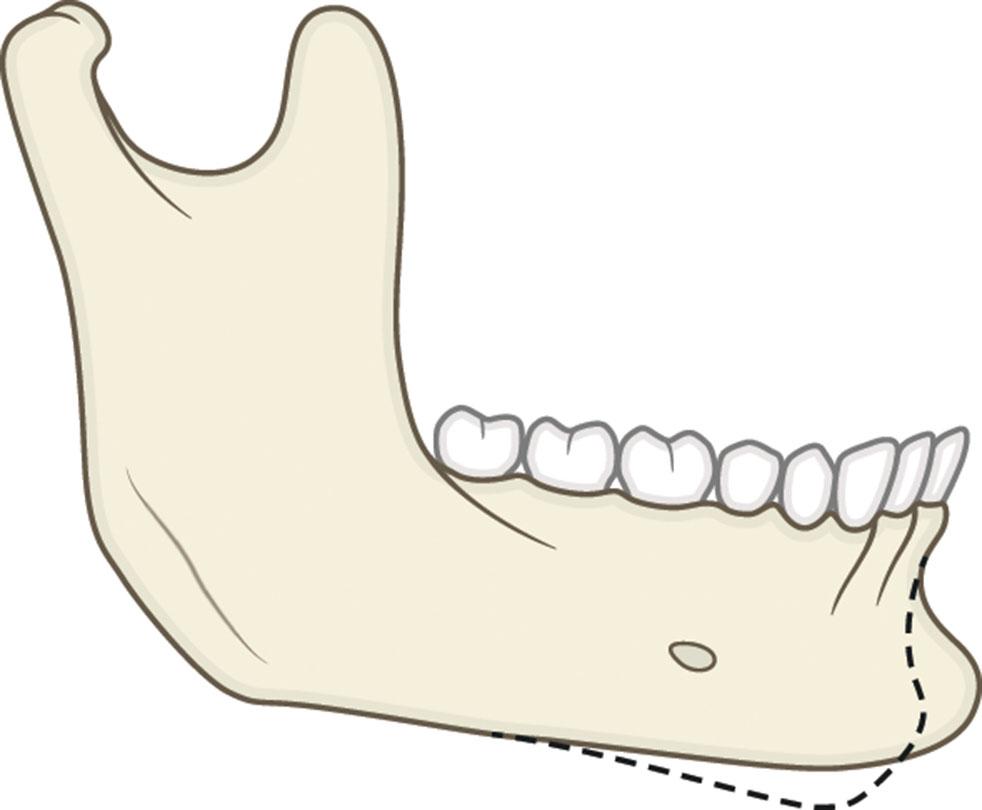
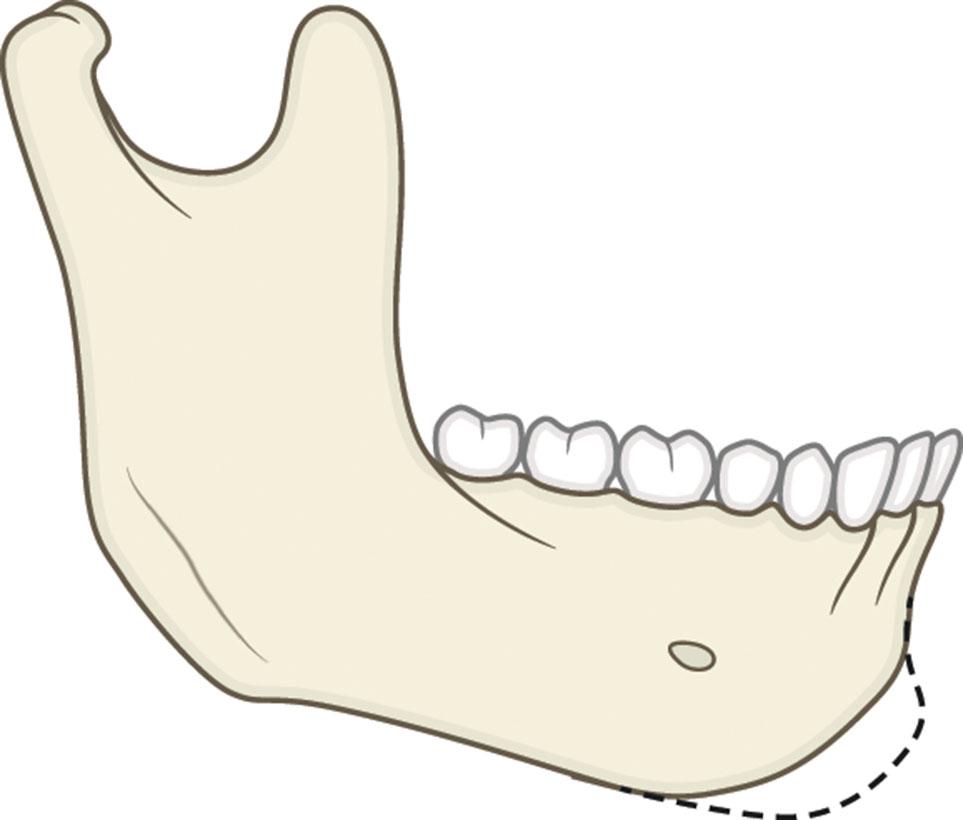
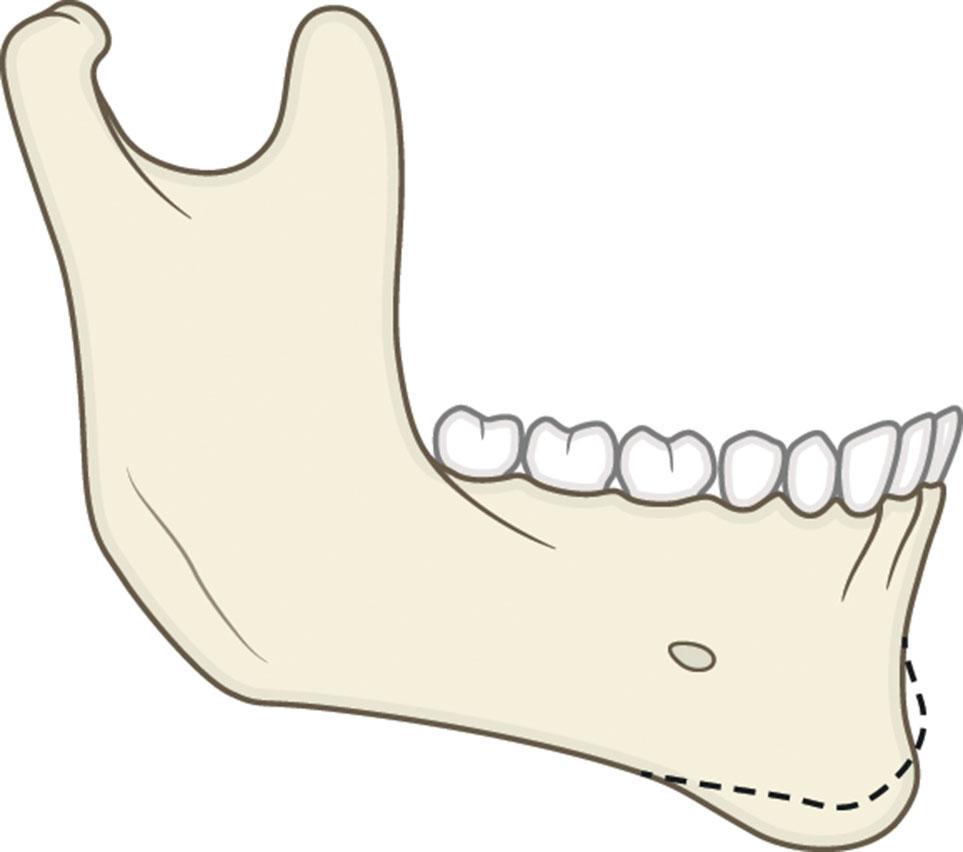
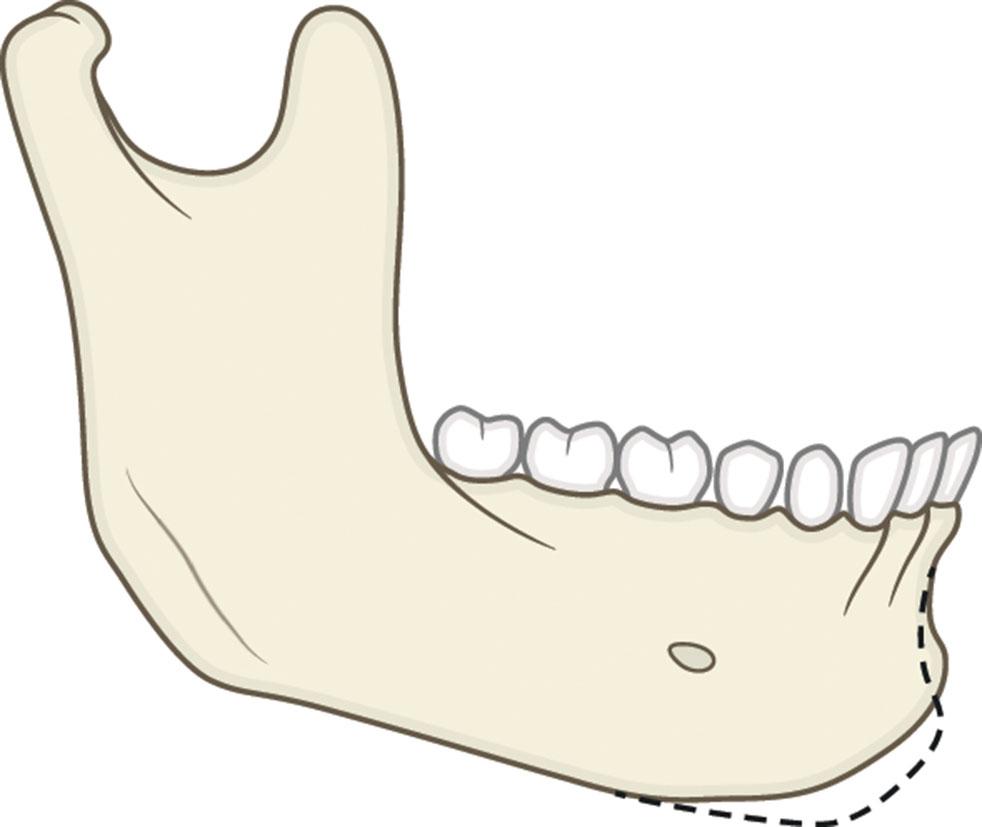
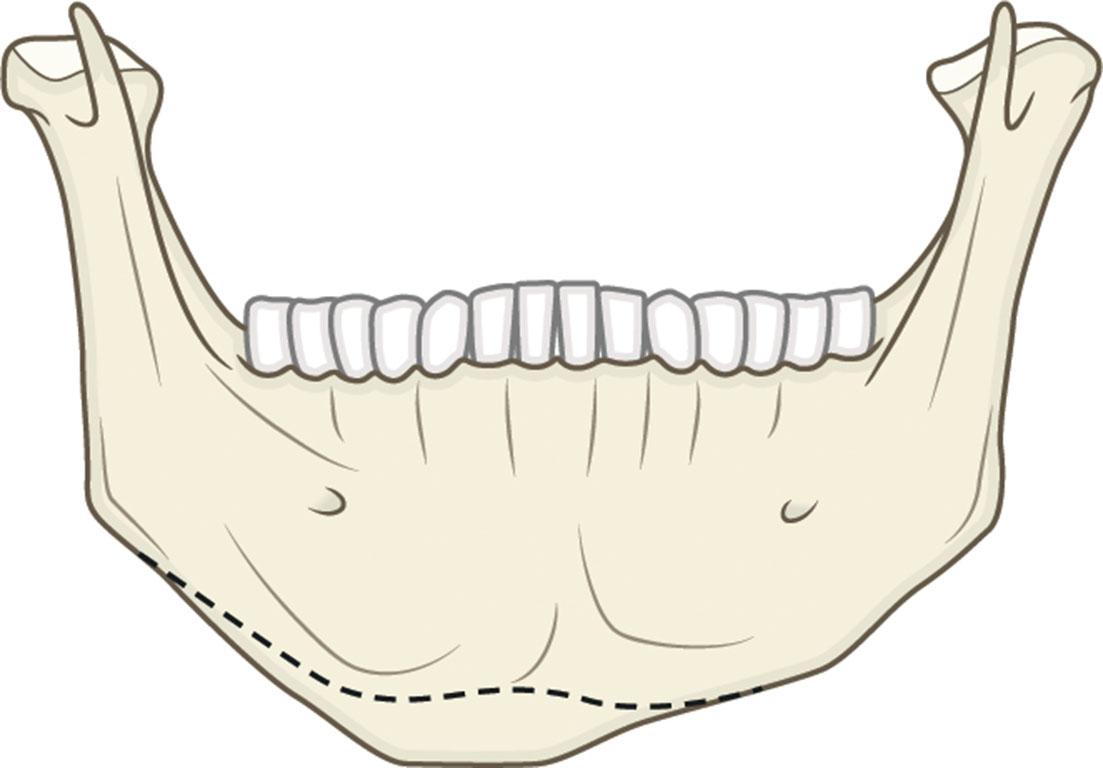
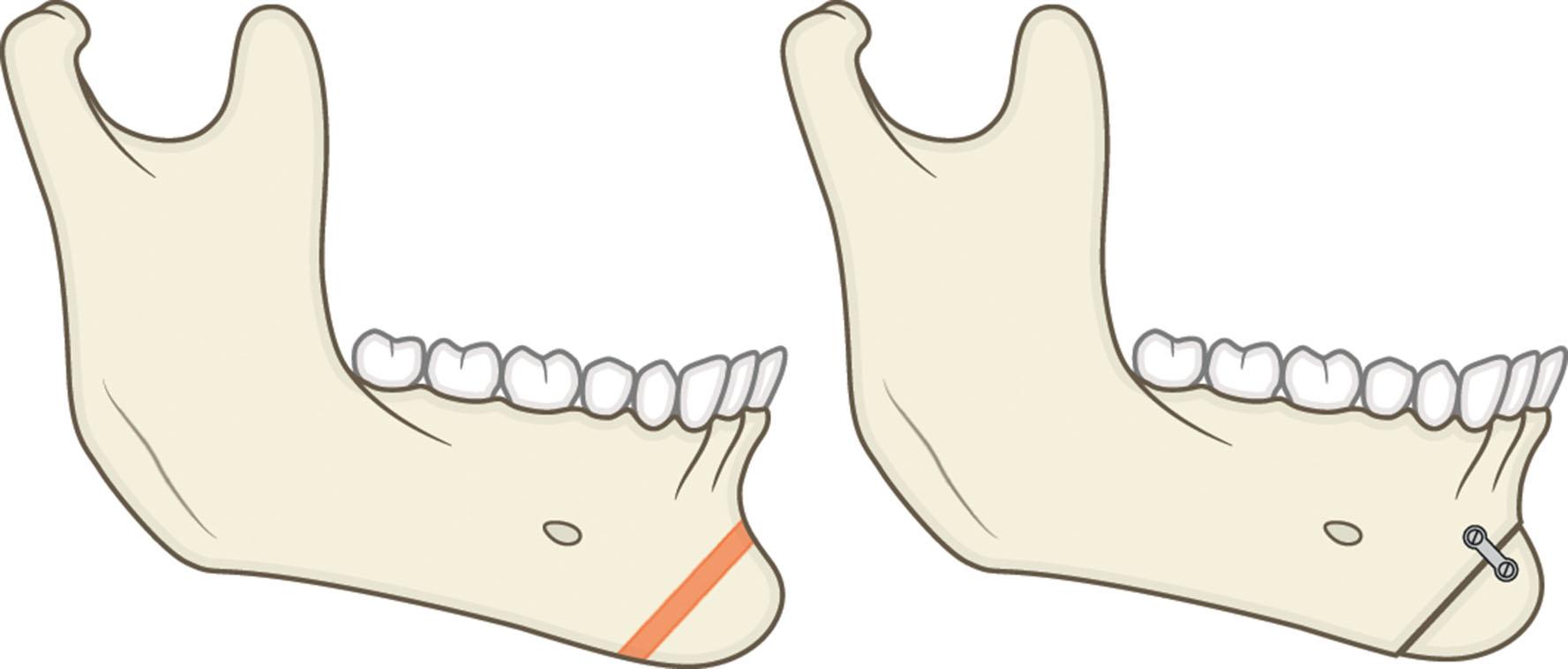
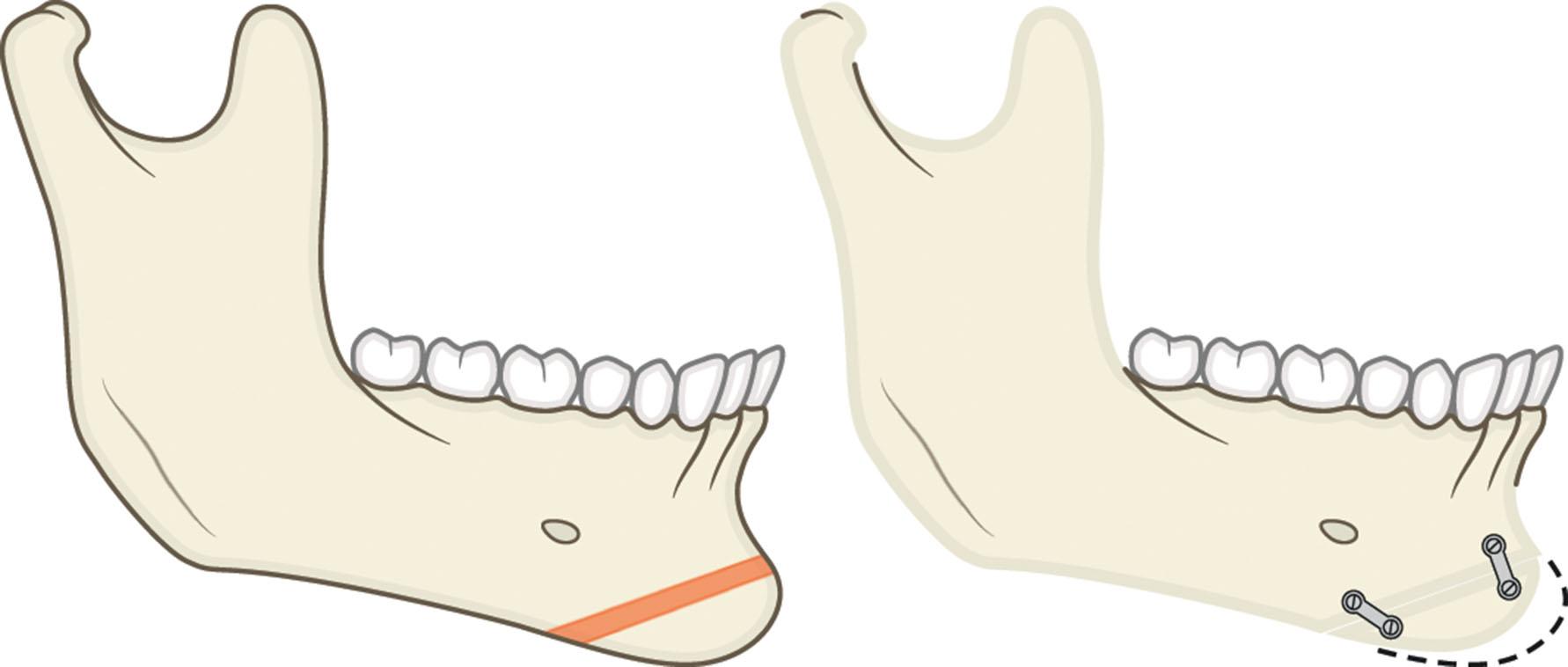
Asymmetric chin can be on a horizontal plane (side to side) or it can have a rotational element as well (clockwise or counterclockwise). It can be short or with increased anterior facial height. In pseudomacrogenia, the size of the chin is larger than normal and excess tissue is due to excess soft tissue with the size of the bone seeming to be normal. This condition also is seen in the patient who has undergone removal of chin implants. In pseudomicrogenia, patients have long face deformity, causing clockwise rotation of the normal mandible. Witch's chin deformity is referred to soft-tissue ptosis of the chin, which is usually seen in the patient with a long history of denture use after full dental extraction or purely due to age. In a study by Guyuron et al ., in an evaluation of 2879 patients, 684 patients were noted to have normal occlusion and some type of chin deformity. Among them 24.9% fell into group I, 63.6% group II, 7.9% group III, 0.6% group IV, 0.73 group V, 0.4% group VI, and 1.9% group VII.
Usually, patients with macrogenia and asymmetry are not good candidates for alloplastic genioplasty, while osteotomy almost always provides predictable improvement or ideal outcome. Therefore, patients with simple microgenia are potential candidates for the alloplastic genioplasty and among this group the patients with mild to moderate microgenia who are older (above age 50) are better candidates for alloplastic genioplasty, while the rest of the chin deformities can be treated with osseous genioplasty with greater success.
In patients with horizontal/vertical or oblique macrogenia (dependent on the deformity), osteotomy is performed by removing a segment of the bone and setting the chin back. Rarely, ostectomy by shaving of the bone using a wide burr can be accomplished ( Fig. 9.13.15 ) for horizontal macrogenia. It should be noted that there is a major difference in soft-tissue response between patients undergoing osteotomy versus ostectomy ( Table 9.13.2 ). The inclination of the osteotomies can be changed to deal with combination of horizontal and vertical excess ( Fig. 9.13.16 ).
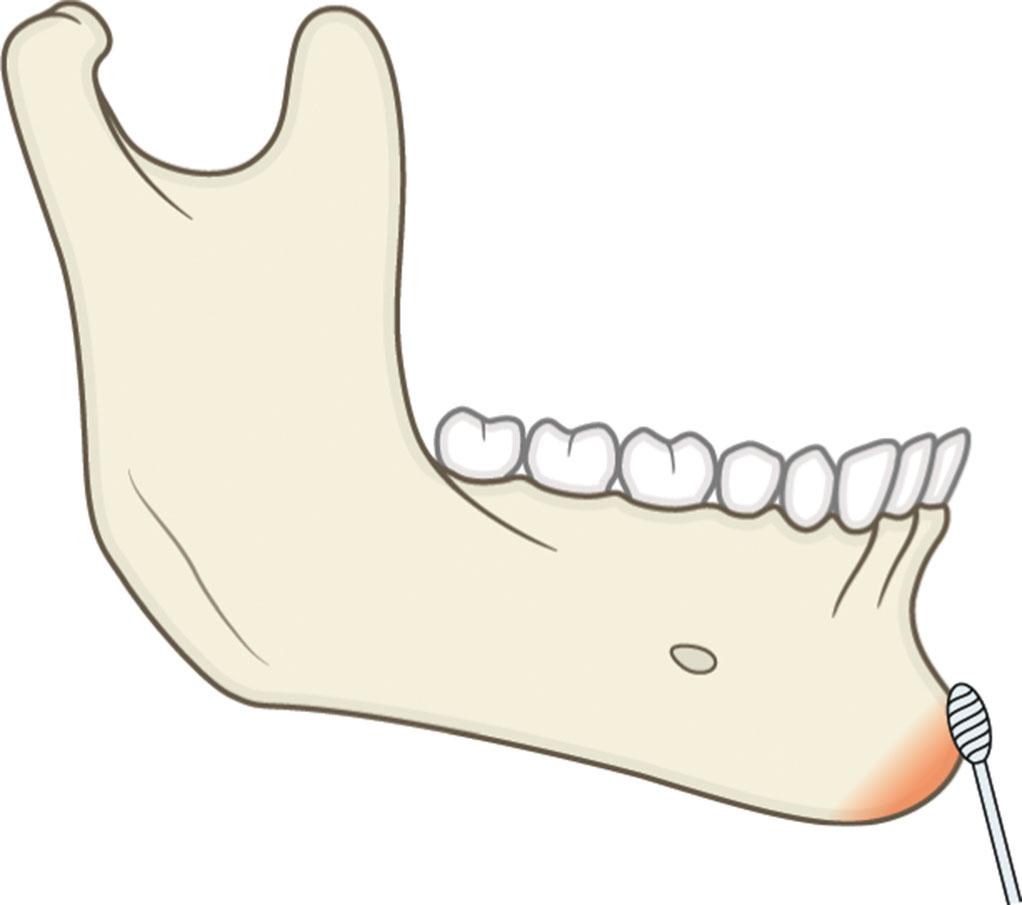
| Procedure | Response |
|---|---|
|
|
|
|
| Augmentation | 0.8 for 1.0 |
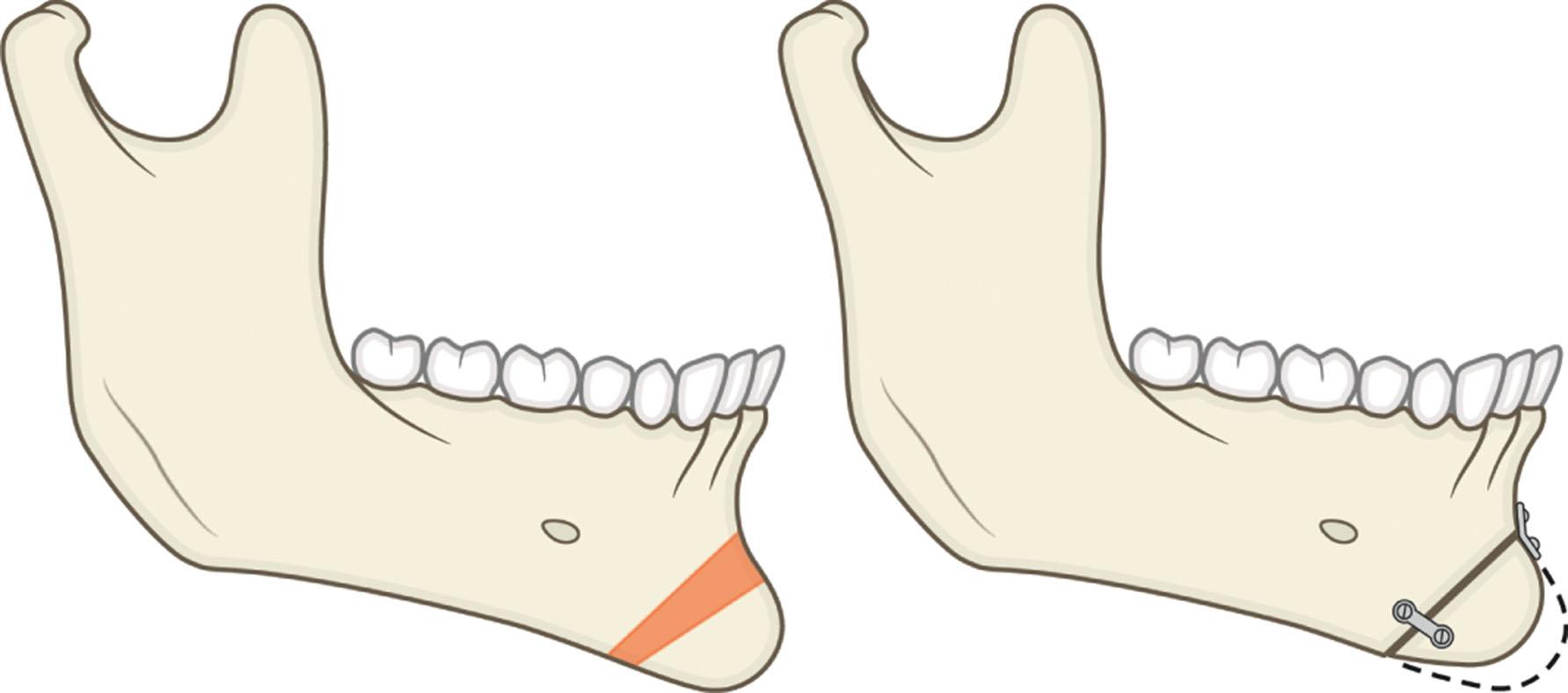
In dealing with microgenia there are more surgical options available. However, since augmentation genioplasty will be discussed in a different chapter, here we will focus on osteotomy. Sliding horizontal osteotomy, which is performed 4–5 mm below the mental foramen, is shown in Fig. 9.13.26 . For a combination of horizontal deficiency and vertical excess, the osteotomy travels posterior and caudal, and by advancing this segment, anterior height is usually decreased. A horizontal step osteotomy is also a possibility, this being more suitable for a wide-angle mandible with steep mandibular plane or a patient who requires significant chin advancement. Two osteotomies are done, and segments are advanced overlapping each other. For severe vertical deficiencies a bone graft can be added between the segments, or if the distances of the two segments is within the osteoplastic jumping distance of 4–5 mm, it can be left without bone grafting. If a patient has vertical deficiency and horizontal excess, rotation of the caudal segment caudally following a horizontal osteotomy can address the issue.
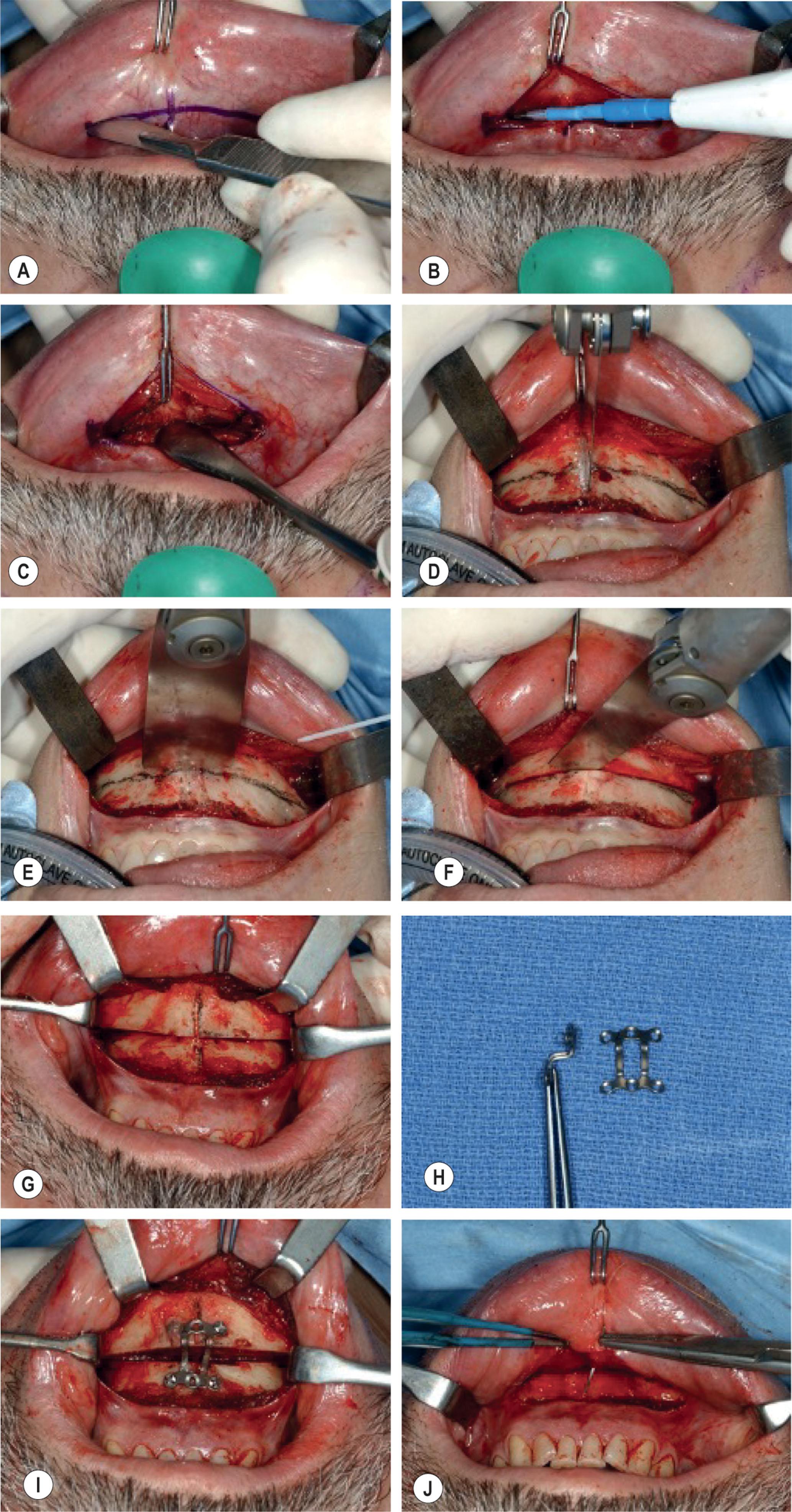
As previously discussed, asymmetric chin is best addressed by an osteotomy, if the asymmetry is limited to the chin area. For isolated chin asymmetry with normal height, a segment from the long side can be removed and added to the short side after wedge osteotomy. If the facial height is small after wedge osteotomy, a bone graft can be added to the short side. If the overall facial height is excessive, a wedge can be removed from the long side. Occasionally, asymmetry is due to horizontal displacement, which can be treated by a horizontal osteotomy and repositioning of the segment in the horizontal plane sliding it side to side.
Pseudomacrogenia , or soft-tissue excess, is treated by excision of the soft tissue through an elliptical incision in the submental area, including skin and subcutaneous layer without disruption of mentalis muscle. Pseeudomicrogenia patients require orthognathic surgery to correct the mandibular rotation. A witch's chin deformity can be treated by a combination of tissue excision using an elliptical incision and application of fat graft to the submental mental crease.
Become a Clinical Tree membership for Full access and enjoy Unlimited articles
If you are a member. Log in here